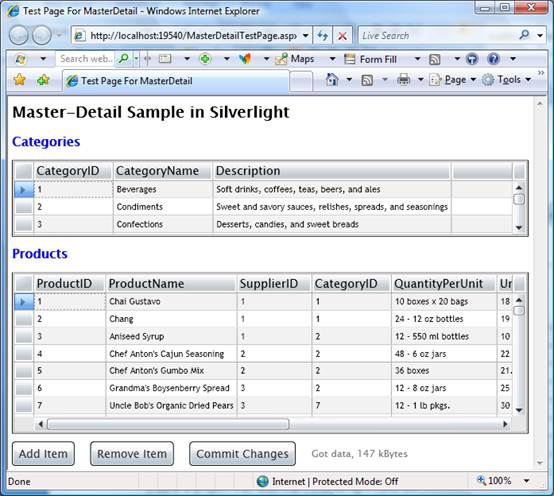After the data is retrieved, we bind it to the controls on the page. Here is the implementation of the BindData method that handles that task:
| C# |
Copy Code
|
|---|---|
void BindData() { // Get the tables we want DataTable dtCategories = _ds.Tables["Categories"]; DataTable dtProducts = _ds.Tables["Products"]; // Populate categories grid _gridCategories.ItemsSource = new DataView(dtCategories, "CategoryID", "CategoryName", "Description"); // Populate products categories grid _gridProducts.ItemsSource = dtProducts.DefaultView; } |
|
The only slightly unusual statement is the one that creates a DataView object and specifies which columns to include in the view. This is an extension provided by the C1.Silverlight.Data implementation that is not present in the original ADO.NET DataView class.
If you run the project now, you see the data retrieved from the server:

Before we continue with the sample, a few comments are in order.
Although the code that binds the data to the controls looks familiar, what happens under the covers is quite different from the traditional WinForms and ASP.NET scenarios. All data binding in WPF and Silverlight is done through reflection. But the DataRowView objects exposed by DataView collections do not have properties that match the columns in the underlying DataTable ("CategoryID", "CategoryName", "Description", and so on).
Note: The binding is possible because the DataView class dynamically creates anonymous types that derive from DataRowView and expose additional properties that correspond to the table columns. Controls can then use reflection to find these properties and bind to them.
The DataRow class also leverages this mechanism through its GetRowView method. This method builds a wrapper object that exposes selected properties of the DataRow and can be used for data binding. You can use this method in your LINQ queries.
For example, the code below builds a LINQ query that selects all categories that start with "C" and exposes their name and description:
| C# |
Copy Code
|
|---|---|
_gridCategories.ItemsSource =
from dr
in dtCategories.Rows
where ((string)dr["CategoryName"]).StartsWith("C")
select dr.GetRowView("CategoryName", "Description");
|
|
If you call GetRowView with no parameters, all columns are exposed.